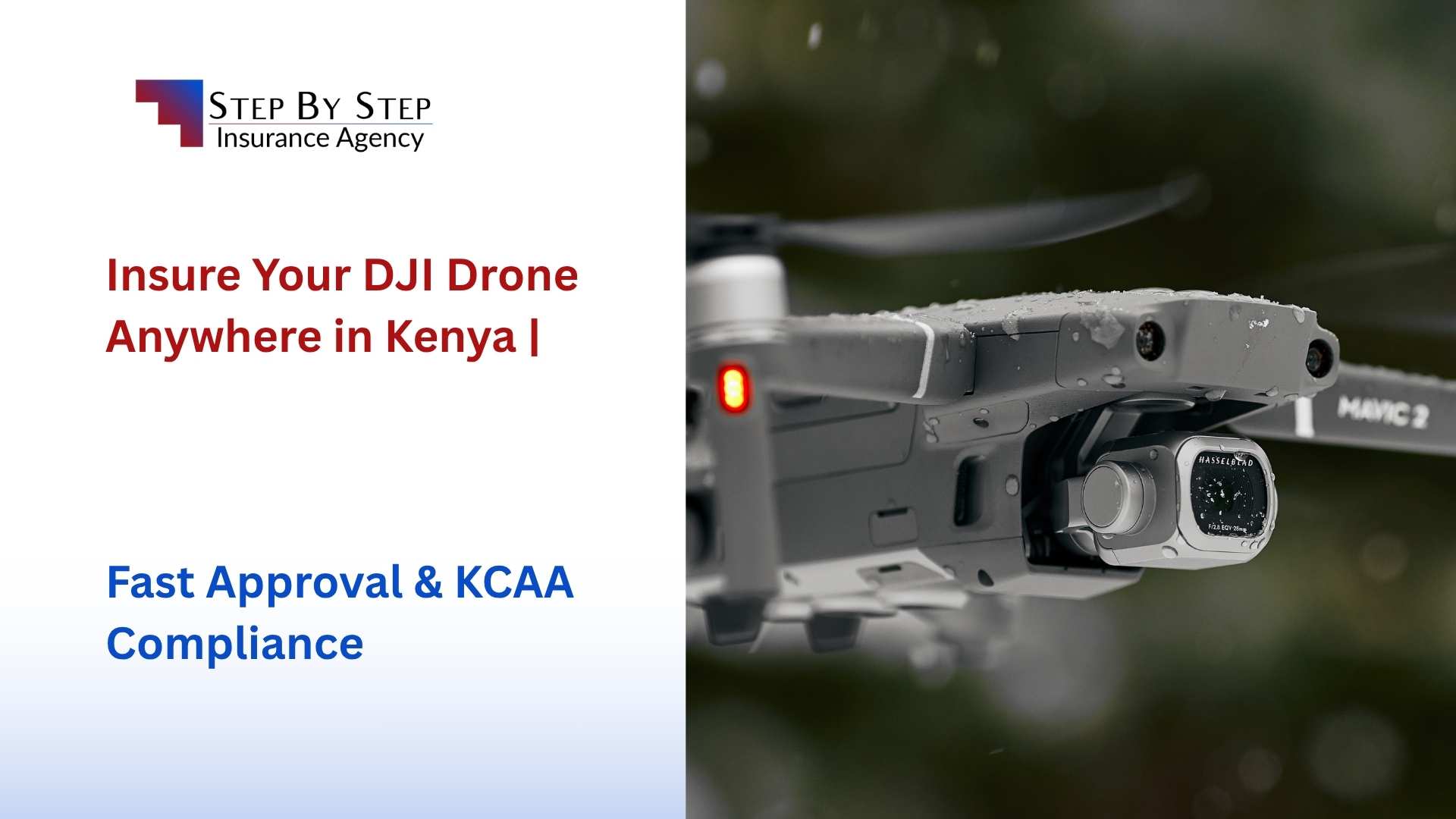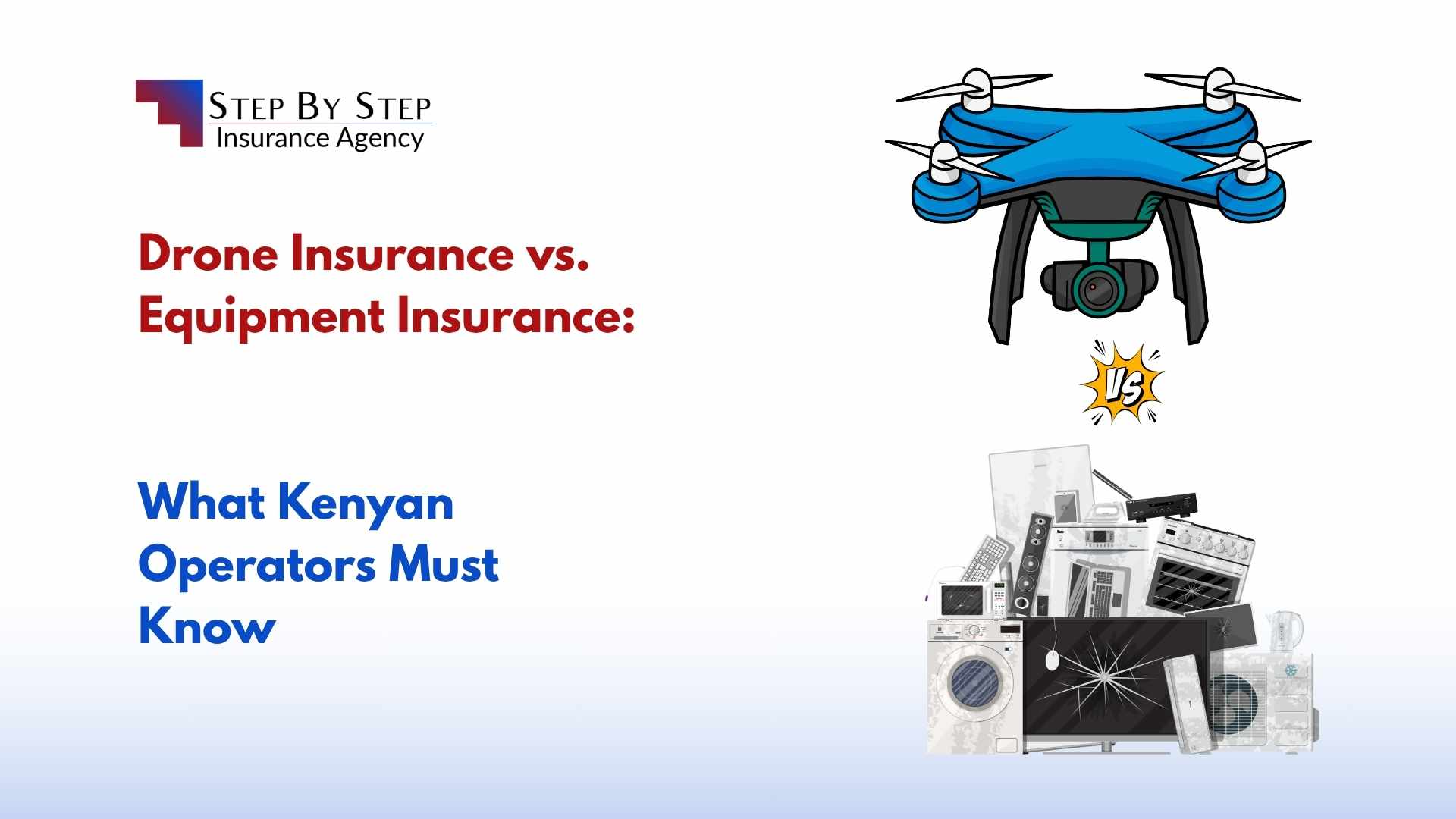Navigating Kenya’s Skies Legally: Why You Need Drone Insurance
The rise of drone technology has transformed various industries in Kenya, from agriculture and filmmaking to delivery services and security.
However, operating a drone is not as simple as buying one and taking to the skies.
The Kenyan government, through the Kenya Civil Aviation Authority (KCAA), has established strict regulations to ensure safe and responsible use of drones, officially referred to as Unmanned Aircraft Systems (UAS).
One critical aspect of compliance is obtaining appropriate drone insurance, which protects both operators and the public.
What is an Unmanned Aircraft System (UAS) – Drone
An Unmanned Aircraft System (UAS), commonly known as a drone, refers to an aircraft that operates without a human pilot onboard.
Instead, it is remotely controlled by an operator or flies autonomously using pre-programmed flight paths and advanced systems like GPS.
A UAS includes not only the drone (the flying vehicle) but also the supporting components necessary for its operation.
Key Components of a UAS
The Drone (Unmanned Aircraft):
The actual flying device, which can vary in size and design depending on its purpose.
Equipped with propulsion systems (motors and propellers), sensors, cameras, and communication equipment.
Ground Control Station (GCS):
A remote control system or software that allows the operator to monitor and control the drone during flight.
This includes joysticks, screens for live video feeds, and flight planning tools.
Data Links:
Communication systems that connect the drone to the Ground Control Station.
These links transmit commands from the operator and send real-time data from the drone (e.g., video footage or flight metrics).
Payload:
The equipment the drone carries, such as cameras, sensors, delivery packages, or agricultural sprayers.
The payload depends on the specific purpose of the drone.
Power System:
Most drones are powered by batteries, but some larger systems use fuel engines.
Types of Drones (UAS)
By Size and Weight:
- Micro Drones: Weigh less than 250g, typically used for recreation or indoor operations.
- Small Drones: Used for tasks like aerial photography and inspections.
- Large Drones: Designed for heavy-duty operations such as delivery or military applications.
By Functionality:
- Recreational Drones: Used by hobbyists for fun and capturing personal videos.
- Commercial Drones: Used for professional purposes like surveying, filmmaking, or delivery.
- Military Drones: Designed for defense applications, including surveillance and combat.
By Flight Mechanism:
- Fixed-Wing Drones: Resemble airplanes and are ideal for long-distance flights.
- Multi-Rotor Drones: Use multiple propellers for vertical takeoff, hovering, and precise movements.
- Hybrid Drones: Combine features of fixed-wing and multi-rotor drones.
Applications of UAS (Drones)
Drones have revolutionized multiple industries globally and in Kenya, with applications such as:
Agriculture:
- Crop monitoring, spraying pesticides, and mapping farmland for precision farming.
Filmmaking and Photography:
- Capturing high-quality aerial shots for movies, events, and advertisements.
Surveillance and Security:
- Monitoring large areas like national parks, private property, or public events.
Logistics:
- Delivering goods, medical supplies, or packages to remote areas.
Disaster Management:
- Assessing damage, delivering emergency aid, and searching for survivors in disaster zones.
Infrastructure Inspections:
- Inspecting bridges, pipelines, and powerlines for maintenance.
Scientific Research:
- Collecting data in remote or hazardous areas for environmental studies.
How UAS (Drones) Work
Drones rely on a combination of technologies to operate effectively:
Flight Control Systems:
- Use sensors like gyroscopes and accelerometers to maintain balance and navigate accurately.
GPS and Navigation:
- Allow the drone to follow pre-programmed routes or respond to manual directions from the Ground Control Station.
Communication Systems:
- Enable real-time control and data transmission between the drone and its operator.
Automation and AI:
- Advanced drones use artificial intelligence to perform tasks like object recognition, obstacle avoidance, and autonomous flight.
Regulation of UAS (Drones) in Kenya
In Kenya, drones are regulated by the Kenya Civil Aviation Authority (KCAA) under the Civil Aviation (Unmanned Aircraft Systems) Regulations, 2020. Key regulations include:
- Registration of drones.
- Licensing of operators.
- Restrictions on where drones can fly (e.g., restricted airspace).
- Mandatory insurance to cover third-party liabilities.
These regulations ensure the safe, legal, and responsible use of drones in Kenyan airspace.
Legal Requirements for Drone Operations in Kenya
Under the KCAA’s Civil Aviation (Unmanned Aircraft Systems) Regulations, 2020, drone operators must meet specific legal requirements to fly in Kenyan airspace.
These include:
Drone Registration
All drones must be registered with the KCAA. Operators are required to submit an application detailing the drone’s specifications, intended use, and owner information.
A registration certificate is issued upon approval.
Pilot Licensing
Individuals operating drones must obtain a Remote Pilot License (RPL) from the KCAA. This involves completing training at a certified institution and passing both theoretical and practical exams.
Operating Permits
Operators must secure permits for specific drone activities, such as aerial photography, surveillance, or delivery services.
The KCAA issues these permits based on the operator’s adherence to safety and operational guidelines.
Adherence to Flight Zones
Kenya’s airspace is divided into restricted, controlled, and open zones. Drone operators must avoid flying in restricted areas, such as near airports, military zones, or government facilities, without explicit permission.
Mandatory Insurance Coverage
A key requirement for regulatory compliance is obtaining drone insurance. This ensures operators are financially liable for any damage or injury caused during drone operations.
How Drone Insurance Ties into Regulatory Compliance
Drone insurance is more than just a safety net, it’s a legal obligation in Kenya. The insurance policy must meet the following requirements:
Third-Party Liability Coverage
The KCAA mandates that all drone operators carry third-party liability insurance.
This covers damages or injuries caused to people, property, or other aircraft.
For instance, if your drone crashes into a vehicle or injures a pedestrian, the insurance will handle compensation claims.
Property Damage Coverage
Drones often operate in environments with potential for property damage, such as buildings, crops, or vehicles.
Insurance protects operators from the financial burden of repairing or replacing damaged property.
Comprehensive Coverage Options
While not mandatory, comprehensive drone insurance is highly recommended. It can include:
Damage to the Drone: Covers repair or replacement costs if the drone is damaged in an accident or due to mechanical failure.
Payload Insurance: Protects expensive equipment or data being carried by the drone, such as cameras or sensors.
In-Transit Coverage: Covers the drone while it is being transported to or from operation sites.
4. Proof of Compliance
Operators must present proof of insurance when applying for permits or during routine inspections by the KCAA.
Failing to provide adequate insurance documentation can result in fines, suspension of permits, or prohibition from operating in Kenyan airspace.
The Consequences of Flying Without Insurance
Operating a drone without the required insurance in Kenya can lead to severe consequences:
1. Fines and Penalties:
The KCAA imposes hefty fines on uninsured operators, especially in cases where drones cause harm or damage.
2. Legal Liability:
In the event of an accident, the operator may face lawsuits and be personally liable for compensation costs, which can be financially devastating.
3. Operational Bans:
Uninsured operators risk having their licenses revoked and being barred from using drones in Kenyan airspace.
Benefits of Drone Insurance Beyond Compliance
Beyond meeting legal requirements, drone insurance offers significant advantages:
1. Peace of Mind:
Operators can focus on their work without worrying about financial risks.
2. Business Credibility:
For commercial operators, having insurance demonstrates professionalism and commitment to safety.
3. Expanded Opportunities:
Insured operators are more likely to secure contracts with organizations that require proof of coverage before collaboration.
Drone Insurance FAQs
These are frequently asked questions on Drone Insurance:
1. Who is eligible for Drone insurance?
- Drones insurance can be taken up by any individual who owns a drone registered with the Kenya Civil Aviation Authority (KCAA).
- The pilots expected to fly the drone are duly trained by the KCAA-approved drone training schools in Kenya.
- Drone Training Schools
- Institutions or private companies e.g. universities, agricultural farms.
2. What documents are needed to apply for drone insurance?
- Duly completed proposal form.
- Kenya Revenue Authority Pin Certificate.
- National ID or Passport for individual clients.
- Certificate of Incorporation for corporate clients
- Kenya Civil Aviation Authority (KCAA) registration certificate for the drone.
- The license for the pilots who will be flying the drone(RPL).
- The license (KCAA) for the training school if the insured trains students on how to operate drones.
3. What are the exclusions in drone insurance policies?
Common exclusions include:
- Damage from wear and tear.
- Illegal activities.
- Non-compliance with drone operation guidelines.
- Mechanical or electrical failure.
- Theft by the owner,
- Loss caused by unlicensed pilots.
Conclusion
Navigating Kenya’s skies as a drone operator requires more than technical skills, it demands full compliance with KCAA regulations, including mandatory insurance coverage.
Drone insurance not only protects against the financial fallout of accidents but also ensures operators can fly confidently within the law.
Whether you’re a hobbyist capturing breathtaking aerial shots or a business leveraging drone technology for innovation, investing in drone insurance is a crucial step in responsible and compliant drone operations in Kenya.
Unmanned Aircraft Systems (UAS), or drones, have emerged as versatile tools transforming industries worldwide, including in Kenya.
From recreational use to advanced commercial applications, drones are redefining how we interact with technology.
However, operating them responsibly requires understanding their components, applications, and regulations.
With their growing accessibility, drones are set to play an even bigger role in shaping the future.
Contact Step By Step Insurance Agency to get your Drone covered.






5 Things Every Kenyan Drone Operator Should Know About Insurance: Drone Insurance Deep Dive - Step By Step Insurance
April 23, 2025 @ 8:21 am
[…] Step By Step Insurance Agency, we help clients understand the full licensing journey and connect them with underwriters who align […]